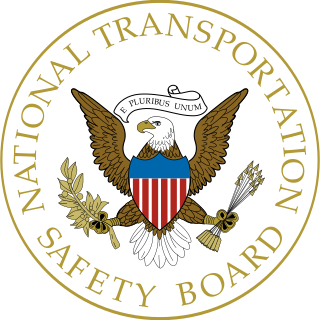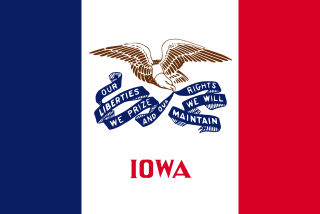
The California Department of Transportation (Caltrans) is an executive department of the US state of California. The department is part of the cabinet-level California State Transportation Agency (CalSTA). Caltrans is headquartered in Sacramento.

The Massachusetts Bay Transportation Authority is the public agency responsible for operating most public transportation services in Greater Boston, Massachusetts. Earlier modes of public transportation in Boston were independently owned and operated; many were first folded into a single agency with the formation of the Metropolitan Transit Authority (MTA) in 1947. The MTA was replaced in 1964 with the present-day MBTA, which was established as an individual department within the Commonwealth of Massachusetts before becoming a division of the Massachusetts Department of Transportation (MassDOT) in 2009.

The National Transportation Safety Board (NTSB) is an independent U.S. government investigative agency responsible for civil transportation accident investigation. In this role, the NTSB investigates and reports on aviation accidents and incidents, certain types of highway crashes, ship and marine accidents, pipeline incidents, and railroad accidents. When requested, the NTSB will assist the military and foreign governments with accident investigation. The NTSB is also in charge of investigating cases of hazardous materials releases that occur during transportation. The agency is based in Washington, D.C. As of December 2014, it has four regional offices located in Anchorage, Alaska; Denver, Colorado; Ashburn, Virginia; and Seattle, Washington. The agency also operates a national training center at its Ashburn facility.

The Dwight D. Eisenhower National System of Interstate and Defense Highways, commonly known as the Interstate Highway System, is a network of controlled-access highways that forms part of the National Highway System in the United States. The system is named for President Dwight D. Eisenhower, who championed its formation. Construction was authorized by the Federal Aid Highway Act of 1956, and the original portion was completed 35 years later, although some urban routes were cancelled and never built. The network has since been extended. In 2016, it had a total length of 48,181 miles (77,540 km). As of 2016, about one-quarter of all vehicle miles driven in the country use the Interstate system. In 2006, the cost of construction was estimated at about $425 billion.

The United States Secretary of Transportation is the head of the United States Department of Transportation, a member of the President's Cabinet, and fourteenth in the Presidential Line of Succession. The post was created with the formation of the Department of Transportation on October 15, 1966, by President Lyndon B. Johnson's signing of the Department of Transportation Act. The department's mission is "to develop and coordinate policies that will provide an efficient and economical national transportation system, with due regard for need, the environment, and the national defense." The Secretary of Transportation oversees eleven agencies, including the Federal Aviation Administration, the Federal Highway Administration, and the National Highway Traffic Safety Administration. In April 2008, Mary Peters launched the official blog of the Secretary of Transportation called The Fast Lane.

Transportation engineering or transport engineering is the application of technology and scientific principles to the planning, functional design, operation and management of facilities for any mode of transportation in order to provide for the safe, efficient, rapid, comfortable, convenient, economical, and environmentally compatible movement of people and goods (transport). It is a sub-discipline of civil engineering. The importance of transportation engineering within the civil engineering profession can be judged by the number of divisions in ASCE that are directly related to transportation. There are six such divisions representing one-third of the total 18 technical divisions within the ASCE (1987).

Light rail, light rail transit (LRT), or fast tram is a form of urban rail transit using rolling stock similar to a tramway, but operating at a higher capacity, and often on an exclusive right-of-way.

The United States Department of Transportation is a federal Cabinet department of the U.S. government concerned with transportation. It was established by an act of Congress on October 15, 1966, and began operation on April 1, 1967. It is governed by the United States Secretary of Transportation.

Bus rapid transit (BRT), also called a busway or transitway, is a bus-based public transport system designed to improve capacity and reliability relative to a conventional bus system. Typically, a BRT system includes roadways that are dedicated to buses, and gives priority to buses at intersections where buses may interact with other traffic; alongside design features to reduce delays caused by passengers boarding or leaving buses, or purchasing fares. BRT aims to combine the capacity and speed of a metro with the flexibility, lower cost and simplicity of a bus system.

In the United States, a farm-to-market road or ranch-to-market road is a state road or county road that connects rural or agricultural areas to market towns. These are better quality roads, usually a highway, that farmers and ranchers use to transport products to market towns or distribution centers.

The Federal Highway Administration (FHWA) is a division of the United States Department of Transportation that specializes in highway transportation. The agency's major activities are grouped into two programs, the Federal-aid Highway Program and the Federal Lands Highway Program. Its role had previously been performed by the Office of Road Inquiry, Office of Public Roads and the Bureau of Public Roads.

Dangerous goods or hazardous goods are solids, liquids, or gases that can harm people, other living organisms, property, or the environment. They are often subject to chemical regulations. In the United States, United Kingdom and sometimes in Canada, dangerous goods are more commonly known as hazardous materials. Hazmat teams are personnel specially trained to handle dangerous goods, which include materials that are radioactive, flammable, explosive, corrosive, oxidizing, asphyxiating, biohazardous, toxic, pathogenic, or allergenic. Also included are physical conditions such as compressed gases and liquids or hot materials, including all goods containing such materials or chemicals, or may have other characteristics that render them hazardous in specific circumstances.

The Los Angeles Metro Rail is an urban rail transportation system serving Los Angeles County, California. It consists of six lines, including two rapid transit subway lines and four light rail lines serving 93 stations. It connects with the Metro Busway bus rapid transit system and also with the Metrolink commuter rail system.

The National Highway System (NHS) is a network of strategic highways within the United States, including the Interstate Highway System and other roads serving major airports, ports, rail or truck terminals, railway stations, pipeline terminals and other strategic transport facilities. Altogether, it constitutes the largest highway system in the world.
Texas state highways are a network of highways owned and maintained by the U.S. state of Texas. The Texas Department of Transportation (TxDOT) is the state agency responsible for the day-to-day operations and maintenance of the system. Texas has the largest state highway system, followed closely by North Carolina's state highway system. In addition to the nationally numbered Interstate Highways and U.S. Highways, the highway system consists of a main network of state highways, loops, spurs, and beltways that provide local access to the other highways. The system also includes a large network of farm to market roads that connect rural areas of the state with urban areas and the rest of the state highway system. The state also owns and maintains some park and recreational roads located near and within state and national parks, as well as recreational areas. All state highways, regardless of classification, are paved roads. The Old San Antonio Road, also known as the El Camino Real, is the oldest highway in the United States, first being blazed in 1691. The length of the highways varies from US 83's 893.4 miles (1,437.8 km) inside the state borders to Spur 200 at just 0.05 miles long.

Air charter is the business of renting an entire aircraft as opposed to individual aircraft seats.

The Connecticut Department of Transportation is responsible for the development and operation of highways, railroads, mass transit systems, ports, waterways in Connecticut.
![Public transport shared transport[ation] service that is available for use by the general public; usually of passengers but sometimes of goods](https://upload.wikimedia.org/wikipedia/commons/thumb/0/0b/R160A_E_Train_entering_World_Trade_Center.jpg/320px-R160A_E_Train_entering_World_Trade_Center.jpg)
Public transport is transport of passengers by group travel systems available for use by the general public, typically managed on a schedule, operated on established routes, and that charge a posted fee for each trip. Examples of public transport include city buses, trolleybuses, trams and passenger trains, rapid transit and ferries. Public transport between cities is dominated by airlines, coaches, and intercity rail. High-speed rail networks are being developed in many parts of the world.


















![Public transport shared transport[ation] service that is available for use by the general public; usually of passengers but sometimes of goods](https://upload.wikimedia.org/wikipedia/commons/thumb/0/0b/R160A_E_Train_entering_World_Trade_Center.jpg/320px-R160A_E_Train_entering_World_Trade_Center.jpg)